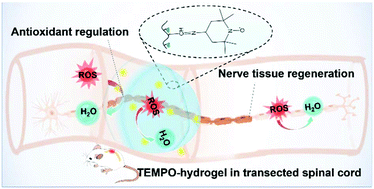Implantation of a functional TEMPO-hydrogel induces recovery from rat spinal cord transection through promoting nerve regeneration and protecting bladder tissue
Abstract
Spinal cord injury is one of the most serious traumatic diseases. The current available clinical therapies are unable to provide effective recovery of nerve functions. Implantation of biomaterial scaffolds is a promising approach to bridge the damaged nerve tissue in the absence of the extracellular matrix. However, the treatments have been impaired by the increased generation of reactive oxygen species in the microenvironment of acute spinal cord injury. Efficient delivery of antioxidants and biocompatible materials and reagents has been a challenge. Herein, a novel hyaluronic acid (HA) hydrogel functionalized with the antioxidant compound 2,2,6,6-tetramethylpiperidinyloxy (TEMPO) is fabricated for nerve tissue regeneration after serious spinal cord transection in rats. TEMPO is tethered onto HA chains to form HA-TEMPO through a Schiff base reaction between 4-amino-TEMPO and aldehyde modified HA chains. The TEMPO-hydrogel is constructed with a highly porous three-dimensional structure via the gelation between the residue aldehydes in HA-TEMPO and the amines in adipic dihydrazide modified HA. The functional TEMPO-hydrogel exhibits the antioxidant effect in an H2O2 simulated in vitro peroxidative microenvironment. Implantation of the functional hydrogel in vivo induces a significant motor function restoration, which could be attributed to the effective functions of the TEMPO-hydrogel in tissue reconnection as well as nerve fiber regeneration of the central nervous spinal cord tissue. Importantly, the treatment with the TEMPO-hydrogel effectively protects the bladder tissue from neurogenic damage. Therefore, the functional TEMPO-hydrogel provides a promising strategy for the treatment of central nervous system diseases through the antioxidant and lesion-bridging regulation of the pathological microenvironment.



 Please wait while we load your content...
Please wait while we load your content...